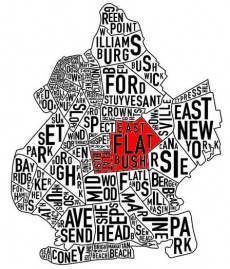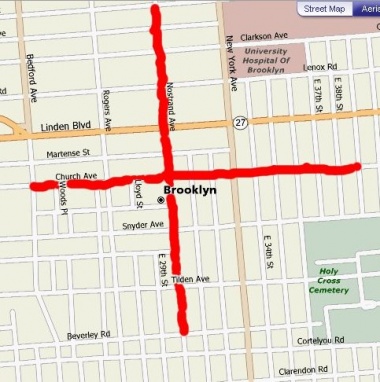Music
From Seminar 2: The Peopling of New York City
Contents |
The Significance of Music
“One good thing about music, when it hits- you feel no pain.” - Bob Marley
History and Traditions
The Caribbean was inhabited by an indigenous people until the Europeans discovered the islands and imposed nearly three centuries of colonial rule. France, Spain, Britain, and the Netherlands brought laborers to the islands, first, West Africans as slaves, then Indians and the Chinese, which unintentionally resulted in an interesting blend of culture (Hebdige, 1987, pp.25-26). Colonization left its mark in the West Indies' rich rhythms, but also left scars in lyrics demanding change. Today, with such close proximity to the cultural hegemony that is United States, it is impossible for the islands of the West Indies to remain uninfluenced by American music (Aparicio, 2003, p.14). The Caribbean is the mixing board of international music, offering a representative sampling of the beats from all over the world.
Afro-Caribbean Music is a mark of pride in one's culture and identity as well as a means of expressing discontent within oppressive systems. The history of Afro-Caribbean people is one marked with slavery, racism, and economic hardship. Unable to overthrow the system, they used music as a means social and political commentary, venting their frustrations and challenging the status quo (West-Duran, 2003, pp.xxiii-xxiv).
Popular West Indian Music Genres
Although music is prevalent throughout the West Indian community in many styles, there are only a few that are popular throughout the islands and internationally.
Reggae
Jamaica is a breeding ground for musical styles. Within a span of five decades, the island has produced at least five different genres of music, but it is Reggae that is most recognized. Reggae was established after the island gained independence from Britain in 1962. The development of this genre was especially significant in the creation of a national identity. Jamaica's struggle to overcome social, political, and economic injustice was reflected in the lyrics, which offered a sense of hope for its people. (Manuel, 1995, pp.143-182)
The history of Reggae is one laden with class strife. The exact origins of the form is unknown because it was poorly documented by the lower class and rejected by the upper class. Many argue that Reggae developed from Rock Steady, Ska, and Mento, earlier forms of Jamaican music. Reggae has a distinctive American blues feel and has applied Rastafarian ideas, which encourages pride in African heritage. Despite the upper class' denouncement of the genre, Reggae flourished and gained popularity worldwide, a true testament to overcoming social class to achieve successful. (Manuel, 1995, pp.143-182)
Calypso
Trinidad is another West Indian nation known for its popular music, among them, the traditional form of Calypso, which grew to prominence in the US and throughout the Caribbean in the 1930s. Calypso, with strong Creole, African, and British influences, began development as a means of slave communication. Later, it became a part of the Carnival celebration as a competition of wit and verbal skills. Also imbibed into daily Trinidadian culture, Calypso responded to the events of the day, was used as a hidden outlet to discuss sex, and was a means of embarrassing and putting down the upper class. But this musical style was also oppressive; Calypso bore sexist and black racist views despite artists themselves being black. There was little Afro-Trinidadian pride until the 1970s when the Black Power movement promoted social equality. (Manuel, 1995, pp.183-210).
Soca
Soca, a modern form of Calypso music with strong East Indian influences, developed after Trinidad gained independence in 1962. Soca is a testament to both changing times and an increase in the Indo-Trinidadian population. This style shifted Calypso from lyrical emphasis to musical emphasis for a dance vibe. It deals with parties, celebrations, and living a fun life for a joyous, rather than a satirical, disposition. However, Soca was not well received by all Trinidadians. It usually faced backlash from the older generation who saw this new style as threat to the traditional Calypso proper, a significantly historic portion of their identity. (Manuel, 1995, pp.193-197).
Today's Tropical "Riddims"
With growing interconnectedness, the sharing of ideas and culture has never been easier nor more inevitable. A world of technological improvements, West Indian migration, and familiar yet foreign rhythms have contributed to the popularity of Caribbean music worldwide.
Reggae has earned a significant spot in American pop culture. It is not only represented in music stores with its own section, but also by Billboard magazine with its own hits chart, as well as satellite and online radios with its own channel (Manuel, 1995, p.144). American popular music today has seen a surge of West Indian artists, such as Rihanna, Sean Kingston, and Sean Paul, and genres, such as Reggaeton, Dancehall, and Soca. American pop music is leaning more heavily on dance beats.
The West Indies today is dominated by American music- rap, R&B, and hip-hop, all of which were shaped by Caribbean music (Aparicio, 2003, pp.14-16). More traditional music like Calypso is played only around Carnival but Calypso, as well as other West Indian genres live on (Manuel, 1995, pp.193-197). West Indian music styles have remained in tact and aside from faster beats, have not changed much over the decades.
Musical genres are traveling around the world, influencing each other and fusing together. Music will undoubtedly continue to evolve.
Sample Local and popular Caribbean music of today
Flatbush: A Musically Vibrant, Afro-Caribbean Community
The Flatbush discussed below consists solely of the intersection of Church and Nostrand Avenues and the immediate few blocks branching off from the two roadways. This region is diverse in terms of the Caribbean nationals encountered, but is markedly more Trinidadian and Jamaican.
Afro-West Indian Identity
Although predominantly West Indian, the community is quite diverse in terms Caribbean nations represented in the area. That these people are able to maintain their individual national identity is a testament to the strength of their loyalty to home. Afro-Caribbean immigrants, including those who moved to the US at a young age, choose to not identify as American. The few Afro-Caribbeans polled who did consider themselves American often made a distinction between African American and West Indian American.
People tend to remain loyal to the music they grew up listening to. Favorites of older West Indian immigrants are oldies and jazz while the younger generation tend to listen to more variety. Yet still, this new generation favor the harmonies of home. Hence, assimilation has been slow, almost undetectable. Only a few Afro-Caribbeans polled had their musical preferences change from West Indian to more American. However, many immigrants listen to more variety, especially more American music in New York than back home, mainly due to easier accessibility. However, a few of the younger West Indians do identify as African AMerican and prefers hip hop and rap, but they also continue to listen to the music of their heritage. Music helps to reinforce identity and pride in ones identity. Because music preferences remain unchanged and lean heavily in favor of West Indian music, it is clear that national pride runs strong and assimilation is not actively encouraged.
In fact, it seems that culture is growing stronger. Caribbean presence is felt throughout Brooklyn and the US as the steel pan, an invention of Trinidad, gains popularity (Allen, 1998, 129-134). The Flatbush community surveyed supports this endeavor through at least two learning centers: Sesame Flyers and a church basement. West Indians are even getting their young children exposed to the drum. Among traditional playground structures, plastic steel pans stood alone. West Indian cultural identity will not wane any time soon.
Inter-Island Relationships
National identity and musical preferences offer insight into identity but may also reveal interesting details about inter-island relationships. A poll indicates that people tend to listen to and prefer music from their own country, but also enjoy music from other nations. People are loyal their identity but at the same time, are able to appreciate the culture of those around them. The common thread seems to be Reggae and Soca music. Because each individual is able to maintain favoritism for their own national music, there is a high degree of tolerance among each island.
However, with everyone so proud of their culture, it seems probable that there must exist some degree of tension. The Trinidadian music scene provides an example of a nation with tensions between two different ethnic groups. On the island, a growing Indian population is inadvertently challenging the Afro-Trinidadian majority (Manuel, 1995, pp.198). A fusion of Indo- and Afro-Trinidadian music is met with great opposition, especially on the Indian front (Manuel, 1995, pp.198-199). The relationship between different islands is not as easy to detect.
There is one encounter worth noting. The incident with Nedda*, a Trinidadian immigrant, in a Dollar Van may have been an isolated incident or could have been truly representative of the emotions that lie in many Afro-Caribbean souls. She expressed extreme frustration about her second generation children's enthusiasm for American and Jamaican culture. She was profoundly disturbed by her son's decision to abandon his Trinidadian culture to engage in Jamaican Reggae. Nedda was outrightly angry and upfront about it.
This incident seemed more dramatic than the truth. There is little indication that there is tension and an everyday rivalry among West Indian immigrants. Although Carnival may get intense, these people are very friendly and were tension to exist, it would be minimal.
The Future
Identity is a concept that is divided and then sub-divided into many categories. It is a concept that affects one's behavior, one's views, and one's relationship with other people. For many, their identity is a no-brainer. When asked about their identity, many people will have an automatic answer, the one that society has imposed. For immigrants and second generation Americans, especially those considered "black," this concept is more complicated. Black people in the US have been grouped into one category and stereotyped, hence immigrants try to distance themselves by showing more pride in their culture and not identifying as African American.
In a street poll, an Afro-Caribbean man, Vincent*, born in the US Virgin Islands and migrated to New York at age three, calls himself American. Although natives of the US Virgin Islands are American citizens, many associate with being West Indian. That he identifies as American is unique; most people polled did not respond that way. That he identifies as just American, as opposed to African American, confirms the need to avoid being stereotyped. That he did not identify as West Indian American is also unique. He may not feel as connected to his culture because he grew up in New York. Vincent admitted that music plays a large role in his life. Although he listens to all types of music, from American to West Indian, his preferences are American- rock, jazz, and hip hop. Vincent also plays the drums in a band- a band that plays African music. He was exposed to African culture rather than West Indian culture when young.
With increasing migrations and cultural awareness, as well as ethnic mixing and interracial marriage, the future of our diverse New York may be represented by more people like Vincent.
Works Cited
Allen, R., & Wilcken, L. (Eds.). (1998). Island Sounds in the Global City. New York: New York Folklore Society.
Aparicio, F.R., & Jaquez, C.F. (Eds.). (2003). Musical Migrations. New York: Palgrave Macmillan.
Hebdige, D. (1987). Cut 'N' Mix. London: The Gresham Press.
Manuel, P., Bilby, K., & Largey, M. (1995). Caribbean Currents. Philadelphia: Temple University Press.
West-Duran, A. (Eds.). (2003). African Caribbeans. Westport, CT: Greenwood Press.
Footnoted Images
1 http://images.google.com/imgres?imgurl=http://www.jamaica-dream-vacation.com/images/map-of-jamaica-with -design-of-national-flag.jpg&imgrefurl=http://www.jamaica-dream-vacation.com/&h=130&w=279&sz=17&hl=en& start=2&um=1&tbnid=6skGGMufpOqCpM:&tbnh=53&tbnw=114&prev=/images%3Fq%3Djamaica%2Bmap%2Band %2Bflag%26um%3D1%26hl%3Den%26client%3Dfirefox-a%26rls%3Dorg.mozilla:en-US:official%26sa%3DG
2 http://images.google.com/imgres?imgurl=http://members.tripod.com/anansiweb/trinidadmapflag.gif&imgrefurl= http://members.tripod.com/anansiweb/trinbago.htm&h=239&w=435&sz=4&hl=en&start=32&um=1&tbnid=lQopQ zeIW_DRMM:&tbnh=69&tbnw=126&prev=/images%3Fq%3Dtrinidad%2Bmap%2Band%2Bflag%26start%3D20%2 6ndsp%3D20%26um%3D1%26hl%3Den%26client%3Dfirefox-a%26rls%3Dorg.mozilla:en-US:official%26sa%3DN
3 http://images.google.com/imgres?imgurl=http://farm3.static.flickr.com/2233/2112152583_c54e96f3a1_o.jpg& imgrefurl=http://gowanuslounge.blogspot.com/2007/12/heres-cool-brooklyn-map.html&h=613&w=528&sz=107& hl=en&start=5&um=1&tbnid=ZAFJskdeBpJtfM:&tbnh=136&tbnw=117&prev=/images%3Fq%3Dbrooklyn%2Bmap %26um%3D1%26hl%3Den%26client%3Dfirefox-a%26rls%3Dorg.mozilla:en-US:official%26sa%3DN
4 http://www.mapquest.com/maps/map.adp?city=East%20Flatbush&state=NY&country=us#a/maps/l:::East+ Flatbush:NY::US:40.653599:-73.930801:city:Kings+County/m::12:40.649575:-73.951527:0::/io:0:::::f:EN:M:/e






